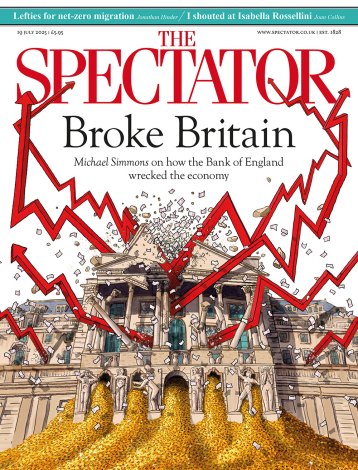
In many ways, Gordon Brown and George Osborne are opposites.
In many ways, Gordon Brown and George Osborne are opposites. When Brown became chancellor, he moved into the smallest, dingiest office on the Treasury’s ministerial corridor — eschewing the grand office that had been used by his predecessors. He also made great play of turning down Dorneywood, which was left to John Prescott. Osborne has restored the natural order of things. He has moved into the best office in the corridor and sent one of his advisers to work in Brown’s old room. He has asserted his claim to Dorneywood, leaving William Hague and Nick Clegg to country-house share. Indeed, Osborne is so keen on his grace-and-favour estate that he went there late last week to work on his conference speech.
To listen to him, it is as if the Chancellor is still fighting the former prime minister. Where there was profligacy, Osborne wants to bring austerity. Where there was control-freakery, he will bring liberalisation. But at times, it does seem that he is protesting a little too much. In more ways than he would care to admit, Mr Osborne is the Mr Brown of this government — the unofficial deputy prime minister running the governmental machine. Such are the similarities that some in the inner sanctum have started to joke about ‘Gordon Osborne’.
Chancellor Osborne, like Brown in Tony Blair’s government, maintains a role as his party’s chief electoral strategist. He, like his predecessor but one, is using all the levers of fiscal policy to reshape British society: Brown wanted to entrench the role of the state in people’s lives and used the tax and benefit system to achieve this; Osborne is trying to unleash what Shirley Letwin called the ‘vigorous virtues’. For both men, fiscal policy is the continuation of politics by other means.
Take the deal on welfare reached with Iain Duncan Smith. It is classic Osborne. He had been presented with a proposal he supported — radical welfare reform — but worried that the IDS scheme had losers as well as winners. What seemed like a straightforward economic point rang alarm bells with Osborne: Labour’s 10p tax disaster showed that having low-income losers is politically toxic, no matter how small the blip in the spreadsheet. So he agreed a two-parliament timetable to cut the cost, and insisted on a ‘no lose’ policy where the new universal benefit would be topped up so that no one on the new system would receive less in cash terms.
Like Brown, he sees economic policy as a political chess match. His plan to withdraw child benefit from households with a higher-rate taxpayer was designed not just to save money, but to pose problems for Labour.
The policy has been predictably unpopular with those newspapers which champion the ‘coping classes’. But this was intentional. Osborne and Cameron believe that, given the pain in store in next month’s spending review, they need to show that the Tories’ natural constituency is taking its share of suffering. Hurting the highest-paid 1.2 million households with children is intended to show that (to use last year’s slogan) ‘We’re all in this together’. All, that is, apart from IDS and the other Cabinet members, who were left in the dark about child benefit cuts until the day of the announcement.
Osborne had braced himself for the scathing editorials. But he consoles himself by thinking that he has left a strategic dilemma for Labour. Oppose the child-benefit changes, and it finds itself having to explain why at this time of national austerity it is favouring benefits going to the best-paid 1.2 million households — and where it is going to find £1 billion to pay for them. If Labour endorses his reform, it would be accepting the beginning of the end for universal benefits. The welfare state would be on its way to being transformed into a safety net, rather than a comprehensive system funded by progressive taxation.
This wider goal was not hinted at during the Tory conference, but it was very much part of the calculation. One friend of Osborne’s was so triumphant the night after the speech that he told me, ‘We’re shrinking the state! Isn’t that what we went into politics to do?’
There was another torpedo sent in Ed Miliband’s direction, a policy commitment that no family should receive more in benefits than the average family earns from working. This is a classic wedge issue, intended to put the opposition on the wrong side of public opinion. If Labour opposes it, then the Tories can portray them as being on the side of the idle. As Cameron said in his speech, ‘Taking more money from the man who goes out to work long hours each day so the family next door can go on living on benefits without working — is that fair?’
Brown had his infamous ‘dividing lines’ and Osborne has his wedge issues. In the Budget, he announced new caps on the amount of housing benefit people can claim. Again, the idea was to force Labour to agree, thereby abandoning a chunk of its constituency that made the difference in several London seats, or else to be seen to side against ordinary voters — and with those who live in some of the most expensive parts of the country at taxpayers’ expense.
This time last year, the Tories were enjoying a 14-point lead in the opinion polls, which would have translated into a majority of about 70 seats. This evaporated, because Brown had played politics so damnably well. He had set the terms of political debate, and the Cameroons felt that as an opposition they had no choice but to follow. Amid their loathing of Brown, there is grudging acknowledgment of the skill with which he used power to Labour’s advantage.
Blair, by contrast, is a lodestar to the Tories. In Birmingham this week, he has been mentioned favourably in speeches, glasses have been raised in his honour and one secretary of state even sleeps with Blair’s autobiography on his bedside table in the place normally reserved for the bible.
In opposition, the Cameroons largely accepted the terms of political debate in this country. Now they are trying to change them—and leave Labour on the wrong side. As they like to say, ‘In opposition you move to the centre. In government, you move the centre.’







Comments